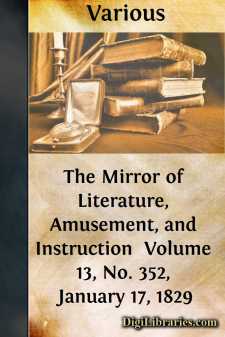Categories
- Antiques & Collectibles 13
- Architecture 36
- Art 48
- Bibles 22
- Biography & Autobiography 813
- Body, Mind & Spirit 142
- Business & Economics 28
- Children's Books 15
- Children's Fiction 12
- Computers 4
- Cooking 94
- Crafts & Hobbies 4
- Drama 346
- Education 46
- Family & Relationships 57
- Fiction 11828
- Games 19
- Gardening 17
- Health & Fitness 34
- History 1377
- House & Home 1
- Humor 147
- Juvenile Fiction 1873
- Juvenile Nonfiction 202
- Language Arts & Disciplines 88
- Law 16
- Literary Collections 686
- Literary Criticism 179
- Mathematics 13
- Medical 41
- Music 40
- Nature 179
- Non-Classifiable 1768
- Performing Arts 7
- Periodicals 1453
- Philosophy 64
- Photography 2
- Poetry 896
- Political Science 203
- Psychology 42
- Reference 154
- Religion 513
- Science 126
- Self-Help 84
- Social Science 81
- Sports & Recreation 34
- Study Aids 3
- Technology & Engineering 59
- Transportation 23
- Travel 463
- True Crime 29
The Mirror of Literature, Amusement, and Instruction Volume 13, No. 352, January 17, 1829
by: Various
Categories:
Description:
Excerpt
PRINCE RUPERT'S PALACE
Prince Rupert, who will be remembered in the annals of the useful and fine arts when his military fame shall be forgotten, resided at a house in Beech-lane, Barbican, of the remains of which the above is a representation. His residence here was in the time of Charles II.; for it is said that Charles paid him a visit, when the ringers of Cripplegate had a guinea for complimenting the royal guest with a "merry peal." As the abode of a man of science, (for the prince was one of the most ingenious men of his time,) this engraving will doubtless be acceptable to the readers of the MIRROR. It, moreover, shows that even at that period, a residence in the City and its neighbourhood was not thought derogatory to a man of rank or fortune.
With the historical character of Prince Rupert, most of our readers are probably familiar. Many useful inventions resulted from his studies, among which are the invention of "Prince's Metal," locks for fire-arms, improvements in gunpowder, &c. After the restoration, he was admitted into the Privy Council. He likewise became a fellow of the newly-founded Royal Society, and a member of the Board of Trade; and to his influence is ascribed the establishment of the Hudson's Bay Company, of which he was the first governor. Orford, Evelyn, and Vertue attribute to him the invention of mezzotinto engraving; but this has been disputed, and, we believe, disproved.
SOME ACCOUNT OF THE COLOSSEUM, IN THE REGENT'S PARK.
By the courtesy of Mr. Hornor, the proprietor, we have been favoured with a private view of the interior of this stupendous building; and, as it is our intention to illustrate the ensuing Number of the MIRROR with a view of the exterior, we shall for the present confine ourselves to such descriptive details as we have been enabled to collect in our recent visit. The interior is, however, in an unfinished state; the works are in actual progress, and the operations of the several artists continue uninterrupted by the access of visiters.
On entering the edifice by the large door in front, a staircase on the right leads to a passage, which communicates with a circular saloon hung with coloured drapery. This room, which, when finished, will be the largest of the kind in London, occupies the whole internal space, or the basement of the building, with the exception of the staircase leading to the summit, which rises like a large column from the centre. This circular saloon is intended for the exhibition of paintings and other productions of the fine arts; and it redounds highly to the credit of Mr. Hornor, that this exhibition is to be entirely free of charge to the artists. Such an introduction of their works to public notice cannot fail to prove mutually advantageous.
It may be here necessary to state that the wall of the building represents a panoramic View of London, as seen from the several galleries of St. Paul's Cathedral—and that the view of the picture is obtained from three galleries—the first of which corresponds, in relation to the view, with the first gallery at the summit of the dome of St....












